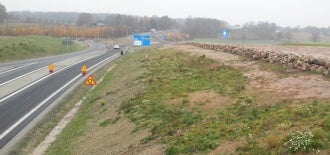
The new planned route of the E22 from Linderödsåsen and north across the Kristianstad plain passes large and important aquifers, which places special demands on a detailed investigation of ground conditions.
The Swedish Transport Administration must present a ‘road plan’ in order to use the land. Highway projects over a certain length also require decisions from the Swedish Government, which set the condition that the Kristianstad plain groundwater must not be contaminated during construction or by future road traffic.
The limestone rock below the Kristianstad plain represents a large groundwater supply that is particularly worthy of protection. The aquifer is the largest in Sweden and is a source of water for several municipalities. It also has significant economic value for the region’s food industry and agriculture. Global engineering consultancy Ramböll, which has collaborated with ABEM for many years, was commissioned by the Swedish Transport Administration to prepare the road plan and carry-out the investigations on which the road plan is based.
"We needed an efficient, sustainable and qualitative measurement method to ensure good decision-making that would make everyone feel secure. There are major environmental and economic interests in the area that must be taken into account," said Ramböll hydrogeologist Elisabet Hammarlund.
Ultimately, equipment and methods for resistivity measurement were chosen to allow measurement and surveying of the various soil layers down to about 70m deep using ABEM Terrameter LS. Of the 16km route, just over 11.5km had to be measured because about 4.5km was already identified as needing groundwater protection.
"After evaluating the data and assessing the security measures that needed to be implemented, we could determine that about 10km of the planned highway would not require sealing measures as a result of the ground conditions that we were able to demonstrate. As a result, the Swedish Transport Administration saved over SEK50m because the sealing measures could now be avoided," Hammarlund added.
To ensure all aspects, supplementary drilling and analyses were carried-out that confirmed the results. Now planning is underway and before the shovel is placed in the ground the road plan has to be adopted, environmental permits obtained and archaeological investigations carried-out.
Construction start is expected in 2016/2017.
Image: The Swedish Transport Administration must present a ‘road plan’ for the new planned route of the E22. Photo: courtesy of ABEM.
